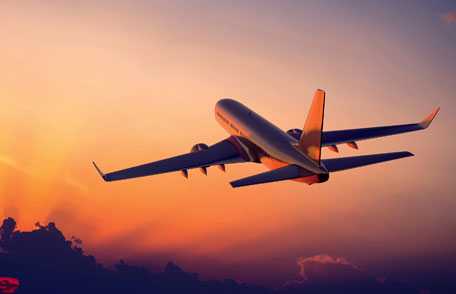Exposure to Pesticides on Aircraft
 Please visit Aircrew Safety and Health for more information on NIOSH research on aircraft disinsection and what crewmembers can do to stay healthy and safe at work.
Please visit Aircrew Safety and Health for more information on NIOSH research on aircraft disinsection and what crewmembers can do to stay healthy and safe at work.
Some countries require that in-bound flights be treated with pesticides to prevent the spread of insects and the diseases they carry. This process is called disinsection. Disinsection methods include spraying the cabin with an insecticide before or after passengers board, while in flight, or treating the aircraft’s inside surfaces while passengers are not on board. Aircrew, groundcrew, and passengers can be exposed to pesticides during disinsection, from contact with treated surfaces, or when eating or drinking products that have come in contact with treated surfaces.
How is disinsection regulated?
Aircraft disinsection is allowed under international law, but not all countries require it. The U.S. Environmental Protection Agency (EPA) has not approved any pesticides for use in passenger cabins on commercial aircraft . The U.S. Department of Transportation provides information on which countries require disinsection on inbound flights.
The only pesticides recommended by the World Health Organization (WHO) for aircraft disinsection [516 KB] are synthetic pyrethroids (permethrin, d-phenothrin, and 1R-trans-phenothrin). Other pesticides, including DDT (dichlorodiphyltrichloroethane), are no longer used. It is unknown whether all aircraft disinsection adheres to the WHO guidelines regarding disinsection , label directions, and good occupational hygiene practices.
Are there concerns about disinsection?
Crewmembers have reported illness from exposure to pesticides on aircraft, including headaches, dizziness, nausea, respiratory symptoms, skin and eye irritation, and other symptoms. Reports from passengers and air crew suggest that there are major differences in how disinsection is performed. There is some uncertainty over whether long-term exposure to the chemicals used for disinsection might cause health effects in air and ground crew.
What can be done to reduce hazards of disinsection?
- All aircraft disinsection should adhere to the WHO guidelines regarding disinsection, label directions, and good occupational hygiene practices.
- Air and groundcrew can talk with their employers or employee representative about their concerns about pesticide exposure.
- Air and groundcrew should avoid skin contact with surfaces that are still wet with pesticide.
Please visit Aircrew Safety and Health for more information on NIOSH research on aircraft disinsection and what crewmembers can do to stay healthy and safe at work.
More Information
More Information
- The Agency for Toxic Substances and Disease Registry (ATSDR): pyrethrins and pyrethroids including toxicological profile
- The Agency for Toxic Substances and Disease Registry (ATSDR): DDT, DDE, and DDD including tox profile
- World Health Organization: Chemicals for Aircraft Disinsection
- 2005 World Health Organization report: Safety of Pyrethroids for Public Use [660 KB]
- American Journal of Industrial Medicine: Pesticide Illness Among Flight Attendants Due to Aircraft Disinsection
- State of California Health and Human Services Agency: Occupational Illness Among Flight Attendants Due to Aircraft Disinsection [804 KB]
- CDC Technical Statement on the Role of Disinsection in the Context of Zika Outbreaks
- Airliner Cabin Environment Research Center
- The Association of Flight Attendants-CWA
- Page last reviewed: March 6, 2017
- Page last updated: March 6, 2017
- Content source:
- National Institute for Occupational Safety and Health
- Page maintained by: Office of the Associate Director for Communication, Digital Media Branch, Division of Public Affairs




 ShareCompartir
ShareCompartir